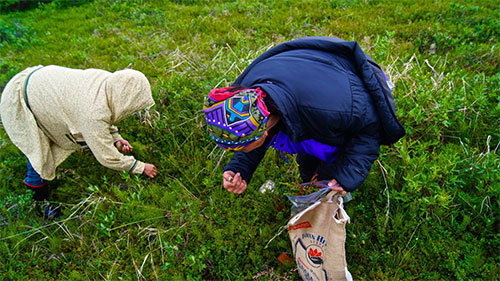
Ties to Alaska's wild plantsEthnobotany film series connects plants with traditional uses
April 28, 2016
The "Ties to Alaska's Wild Plants" project was funded by a grant from the National Science Foundation to Betcher and principle investigator Steffi Ickert-Bond, the Herbarium curator at the University of Alaska Museum of the North. The videos have been published online in a variety of locations and are accessible for free.
Gathering wild plants near Kotzebue, Alaska. "We want to make sure people know that they are available to anyone who can find them useful," Betcher said. "Iñupiaq people, anyone who is interested in ethnobotany and scientist with an interest in botany who want to learn about the cultural uses of plants. This medium helps people remember the information more than just reading about it." Betcher finished the first film in the series to honor Tlingit elder Helen Watkins, who passed away this winter. It features footage filmed in Juneau, Alaska of Watkins processing the devil's club plant to make beads, medicinal powder and infused salves and oils. The post has already received more than 2,500 views on the museum's YouTube channel. Most of the films document Iñupiat traditions, but Betcher said there is interest in expanding the scope to explore the traditional uses of plants in other cultures and communities throughout northern latitudes. The idea for the series came when Betcher, who has a background in conservation biology and spent many years as an interpretive ranger, took an ethnobotany class at the University of Alaska Fairbanks. The class took place in Kotzebue and included students and elders from Point Hope, Ambler, Norvik and different villages. Each day, an elder shared traditional uses of plants with the participants. Betcher said these are cultures that have taught these traditions orally. The people learned it by watching family members. "That is what I love about documenting that through film because you are a little bit closer to recording it in a way that mirrors a traditional way of learning," she said. "You can watch that person processing the plant." Ickert-Bond said the project is timely, especially in the face of climate change and the loss of traditional knowledge. "We wanted to bring the information particularly to Alaska Native youths in their communities," she said. "This was in response to concerns from the elders that the knowledge is not being transmitted. Video is useful in this day and age and an easy medium to feature in museums, exhibits and in classrooms." Betcher said the films can provide researchers with a context for culture, place and a way of life, which can be very helpful in framing a topic. "I worked with an ice scientist who was just starting her doctorate. She was able to discover what was important to Alaska Native people and how they use the natural world before choosing a topic for her research."
The films are archived on the Museum of the North's website
Edited by Mary Kauffman, SitNews
Source of News:
Representations of fact and opinions in comments posted below are solely those of the individual posters and do not represent the opinions of Sitnews.
|
||
